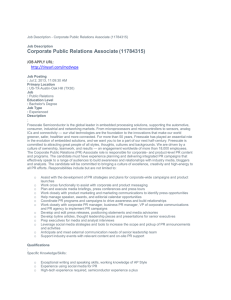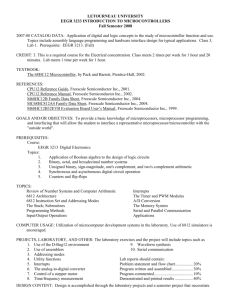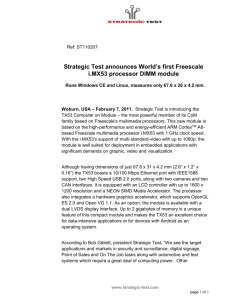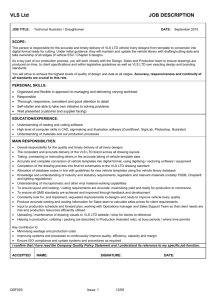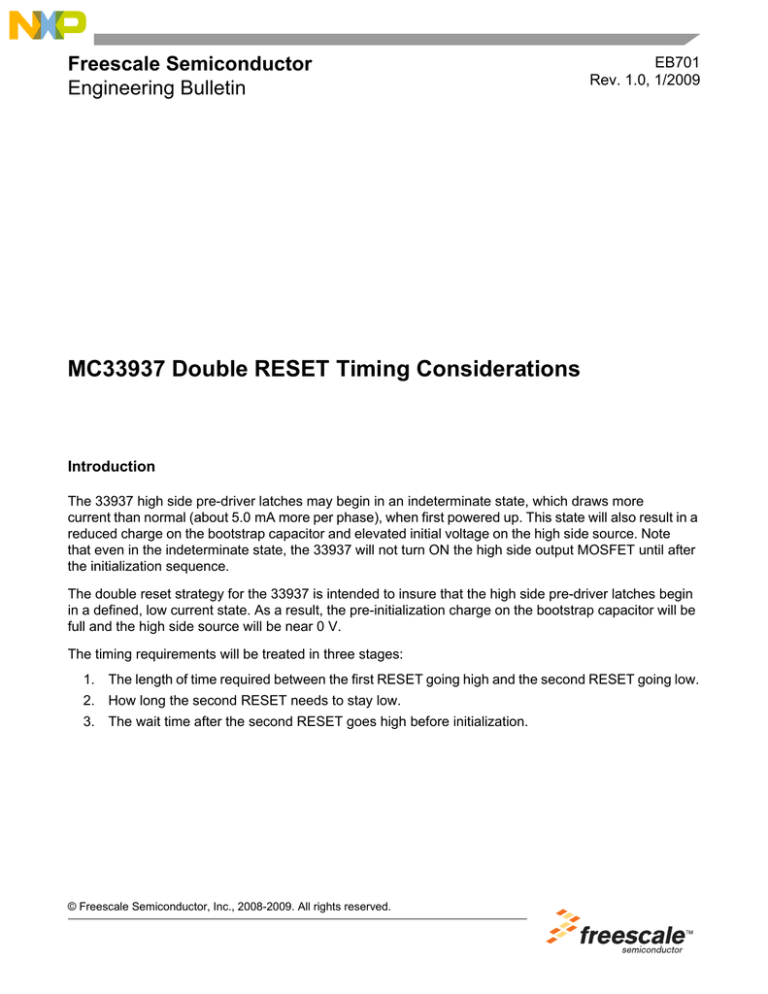
Freescale Semiconductor
Engineering Bulletin
EB701
Rev. 1.0, 1/2009
MC33937 Double RESET Timing Considerations
Introduction
The 33937 high side pre-driver latches may begin in an indeterminate state, which draws more
current than normal (about 5.0 mA more per phase), when first powered up. This state will also result in a
reduced charge on the bootstrap capacitor and elevated initial voltage on the high side source. Note
that even in the indeterminate state, the 33937 will not turn ON the high side output MOSFET until after
the initialization sequence.
The double reset strategy for the 33937 is intended to insure that the high side pre-driver latches begin
in a defined, low current state. As a result, the pre-initialization charge on the bootstrap capacitor will be
full and the high side source will be near 0 V.
The timing requirements will be treated in three stages:
1. The length of time required between the first RESET going high and the second RESET going low.
2. How long the second RESET needs to stay low.
3. The wait time after the second RESET goes high before initialization.
© Freescale Semiconductor, Inc., 2008-2009. All rights reserved.
How long does the first RESET remain high?
How long does the first RESET remain high?
The first RESET must remain high long enough for VDD and VLS to reach the full regulated voltage. The
normal time for this to occur is specified as 2.0 ms maximum. If there is more capacitance on VLS or VDD
than the nominal values given in the specification, this time may need to be increased. In general, the time
may be safely scaled linearly with the capacitance. If the charge pump is used, it may also increase this
time. An estimate of increased time due to charge pump would be to add 25%. For example, the nominal
VLS capacitance is 2.2 μF on both VLS and VLS_CAP. If that value is doubled to 4.4 μF on each pin, the
power up time should be increased to 4.0 ms; 5.0 ms if using the charge pump.
How long does the second RESET remain low?
The second RESET must remain low long enough for VDD to decay below the POR threshold as a
minimum. The POR threshold is specified as 4.5 V max and 3.4 V min. (MC33937 data sheet. Look for
VTHRST in the Static Electrical Characteristics table). The load on VDD may be treated as a resistive load
of 570 Ω ±25% on 5.0 V (variations in VDD have already been taken into consideration in the equivalent
resistance calculation). Minimum time to guarantee reaching POR is:
t POR = 570Ω • ( 1.25 ) • C VDD • ln ( 5 ⁄ 3.4 )
= 275Ω • C
VDD
So if the capacitance used on VDD is 1.0 μF ±20%, the minimum time for tPOR would be
t POR = 275Ω • 1.0μF • 1.2
= 330 μs
The second RESET must not last so long that VLS decays below the threshold to operate the high side
pre-driver latches. Since under the worst case conditions the high side latches act like a 3.0 V clamp with
a 270 ohm series resistance, VLS needs to be greater than 3.0 V plus three diode drops, or approximately
5.1 V ±0.6 V. If VLS decays below this voltage, there will no longer be sufficient bias to prevent bleeding
critical charge from the bootstrap capacitor. Analysis of the current paths and measurements of currentvoltage characteristics shows that the high side latch behaves like a 3.0 V clamp with a 270 ohm series
resistance. The path to ground from HS_S is 40 kohm ±20%, in parallel with 1750 ohm in series with two
diodes, until VDD reaches 1.0 V ±30%, at which time it becomes 40 kohm in parallel with 100 μA
maximum in series with a diode.
VLS will not begin to decay until after POR has occurred.
The time for VDD to decay to 0.7 V is given by:
t HOLD = 570Ω • ( 1.25 ) • C VDD • ln ( 5 ⁄ 0.7 )
= 1401 Ω • C
VDD
MC33937 Double Reset Timing Considerations, Rev. 1.0
2
Freescale Semiconductor
How long does the second RESET remain low?
Using our 1.0 μF example:
t HOLD = 1401Ω • 1.0μF • 1.2
= 1.68 ms
The voltage on VLS at tHOLD is given by:
VLS ( t HOLD ) = ( VLS – V OS ) • exp ( – t HOLD ⁄ ( C VLS • ( R LATCH + R PD ) ⁄ 3 ) ) + V OS
Where:
V OS = 3V • ( 1.20 ) + 3 • 0.7V
= 5.7V
R LATCH = 270Ω • ( 0.80 )
R PD = 1750Ω • ( 0.80 )
( R LATCH + R PD ) ⁄ 3 = ( 270Ω + 1750Ω ) • 0.8 ⁄ 3
= 538.7Ω
VLS ( t HOLD ) = ( VLS – 5.7V ) • exp ( – t HOLD ⁄ ( C VLS • 538.7Ω ) ) + 5.7V
If VLS is assumed to be 13 V (a low charge pump voltage at low battery condition) and using 2.2 μF ±20%
on each VLS and VLS_CAP (total of 4.4 μF), the VLS voltage at our example tHOLD is:
VLS ( 1.68ms ) = ( 13V – 5.7V ) • exp ( – 1.68ms ) ⁄ ( 4.4μF • ( 0.8 • 538.7Ω ) ) + 5.7V
= 8.71V
The rate of voltage change of VLS can be approximated for time after tHOLD, by assuming the average
current discharging the VLS capacitors is the sum of all hold-off currents (max 100 μA per phase), plus
(VLS(tHOLD) – (VCLAMP + VDIODE))/ RPULL-DOWN / 2 per phase. This approximation is good down to the
clamp voltage of the high side latch, which is the minimum voltage for recovering the second RESET.
I VLS = 3 • ( 100μA + ( VLS ( t HOLD ) – ( V CLAMP + V DIODE ) ) ⁄ R PD ⁄ 2 )
= 300μA + 3 • ( VLS ( t HOLD ) – ( 3 • 1.2 + 0.7 ) ) ⁄ ( 40kΩ • 0.8 ) ⁄ 2
= 3 • V LS ( t HOLD ) ⁄ 64kΩ + 98μA
MC33937 Double Reset Timing Considerations, Rev. 1.0
Freescale Semiconductor
3
How long after second RESET before device can be initialized?
For the example:
I VLS = 3 • 8.71V ⁄ 64kΩ + 98μA
= 506μA
The rate of voltage change is:
δVLS ⁄ δt = I VLS ⁄ C VLS
For the example:
δVLS ⁄ δt = 506μA ⁄ ( 4.4μF • 0.8 )
= 144V ⁄ s
The time for VLS to decay to the minimum acceptable value is:
Δt = ( VLS ( t HOLD ) – ( V CLAMP + V DIODE ) ) ⁄ ( ( δVLS ) ⁄ δt )
For the example:
Δt = ( 8.71V – ( 3.0V • 1.2 + 0.7V ) ) ⁄ 144V ⁄ s
= 30.6ms
The maximum time for the second RESET pulse to be low is:
t 2ND = t POR + t HOLD + Δt
For the example:
t 2ND = 0.33ms + 1.68ms + 30.6ms
= 32.6ms
How long after second RESET before device can be initialized?
As soon as VDD and VLS have recovered the device can continue the normal initialization sequence. This
recovery time will be less than the initial power up time, so it is always safe to use that time as the settling
time for the second RESET recovery.
MC33937 Double Reset Timing Considerations, Rev. 1.0
4
Freescale Semiconductor
Double Reset timing Considerations
Double RESET timing calculator
Here is a handy calculator to compute a good set of timing parameters for the double RESET. These
calculations have been designed to yeild results that are valid over the full temperature range for the
production version of the 33937. Modify the values highlighted in yellow in the DATA table. The RESULTS
table will automatically calculate and update the recommended limits for the double reset.
Table 1. Data
Capacitance
On
Tol
VDD
0.47
μF
20.00%
VLS
2.20
μF
20.00%
VLS_CAP
2.20
μF
20.00%
13.00
VLS
V
The stable VLS voltage, also VLS at the end of tSTART.
Table 2. Calculations
5.70
V
3.0 V clamp + 20% + 3 * 0.7 V diode drops
t3.4
0.000155
s
Maximum time for VDD to decay to 3.4 V (Latest POR, tSTART)
tHOLD
0.000790
s
Maximum time for VDD to decay to 0.7 V (Latest transistion to constant current drain)
VLS2
10.51
V
VLS when transistion to constant current drain
V/s
3*(100μA + Iave_phasecomp)/CVLS Rate of decay with maximum constant current drain.
s
Time to decay from VLS2 to VDHS.
VDHS
δVLS/δt
167.96
Δt
0.036988
t2ND_MAX
37.93
ms
Table 3. Results
Min
Max
tSTART
2.00
t2ND
0.16
tEND
2.00
RESET
tSTART
-
ms
37.93
-
ms
ms
t2ND
tEND
MC33937 Double Reset Timing Considerations, Rev. 1.0
Freescale Semiconductor
5
How to Reach Us:
Home Page:
www.freescale.com
Web Support:
http://www.freescale.com/support
USA/Europe or Locations Not Listed:
Freescale Semiconductor, Inc.
Technical Information Center, EL516
2100 East Elliot Road
Tempe, Arizona 85284
+1-800-521-6274 or +1-480-768-2130
www.freescale.com/support
Europe, Middle East, and Africa:
Freescale Halbleiter Deutschland GmbH
Technical Information Center
Schatzbogen 7
81829 Muenchen, Germany
+44 1296 380 456 (English)
+46 8 52200080 (English)
+49 89 92103 559 (German)
+33 1 69 35 48 48 (French)
www.freescale.com/support
Japan:
Freescale Semiconductor Japan Ltd.
Headquarters
ARCO Tower 15F
1-8-1, Shimo-Meguro, Meguro-ku,
Tokyo 153-0064
Japan
0120 191014 or +81 3 5437 9125
support.japan@freescale.com
Asia/Pacific:
Freescale Semiconductor Hong Kong Ltd.
Technical Information Center
2 Dai King Street
Tai Po Industrial Estate
Tai Po, N.T., Hong Kong
+800 2666 8080
support.asia@freescale.com
For Literature Requests Only:
Freescale Semiconductor Literature Distribution Center
P.O. Box 5405
Denver, Colorado 80217
1-800-441-2447 or 303-675-2140
Fax: 303-675-2150
LDCForFreescaleSemiconductor@hibbertgroup.com
EB701
Rev. 1.0, 1/2009
Information in this document is provided solely to enable system and software
implementers to use Freescale Semiconductor products. There are no express or
implied copyright licenses granted hereunder to design or fabricate any integrated
circuits or integrated circuits based on the information in this document.
Freescale Semiconductor reserves the right to make changes without further notice to
any products herein. Freescale Semiconductor makes no warranty, representation or
guarantee regarding the suitability of its products for any particular purpose, nor does
Freescale Semiconductor assume any liability arising out of the application or use of any
product or circuit, and specifically disclaims any and all liability, including without
limitation consequential or incidental damages. “Typical” parameters that may be
provided in Freescale Semiconductor data sheets and/or specifications can and do vary
in different applications and actual performance may vary over time. All operating
parameters, including “Typicals”, must be validated for each customer application by
customer’s technical experts. Freescale Semiconductor does not convey any license
under its patent rights nor the rights of others. Freescale Semiconductor products are
not designed, intended, or authorized for use as components in systems intended for
surgical implant into the body, or other applications intended to support or sustain life,
or for any other application in which the failure of the Freescale Semiconductor product
could create a situation where personal injury or death may occur. Should Buyer
purchase or use Freescale Semiconductor products for any such unintended or
unauthorized application, Buyer shall indemnify and hold Freescale Semiconductor and
its officers, employees, subsidiaries, affiliates, and distributors harmless against all
claims, costs, damages, and expenses, and reasonable attorney fees arising out of,
directly or indirectly, any claim of personal injury or death associated with such
unintended or unauthorized use, even if such claim alleges that Freescale
Semiconductor was negligent regarding the design or manufacture of the part.
Freescale™ and the Freescale logo are trademarks of Freescale Semiconductor, Inc.
All other product or service names are the property of their respective owners.
© Freescale Semiconductor, Inc. 2008-2009. All rights reserved.


